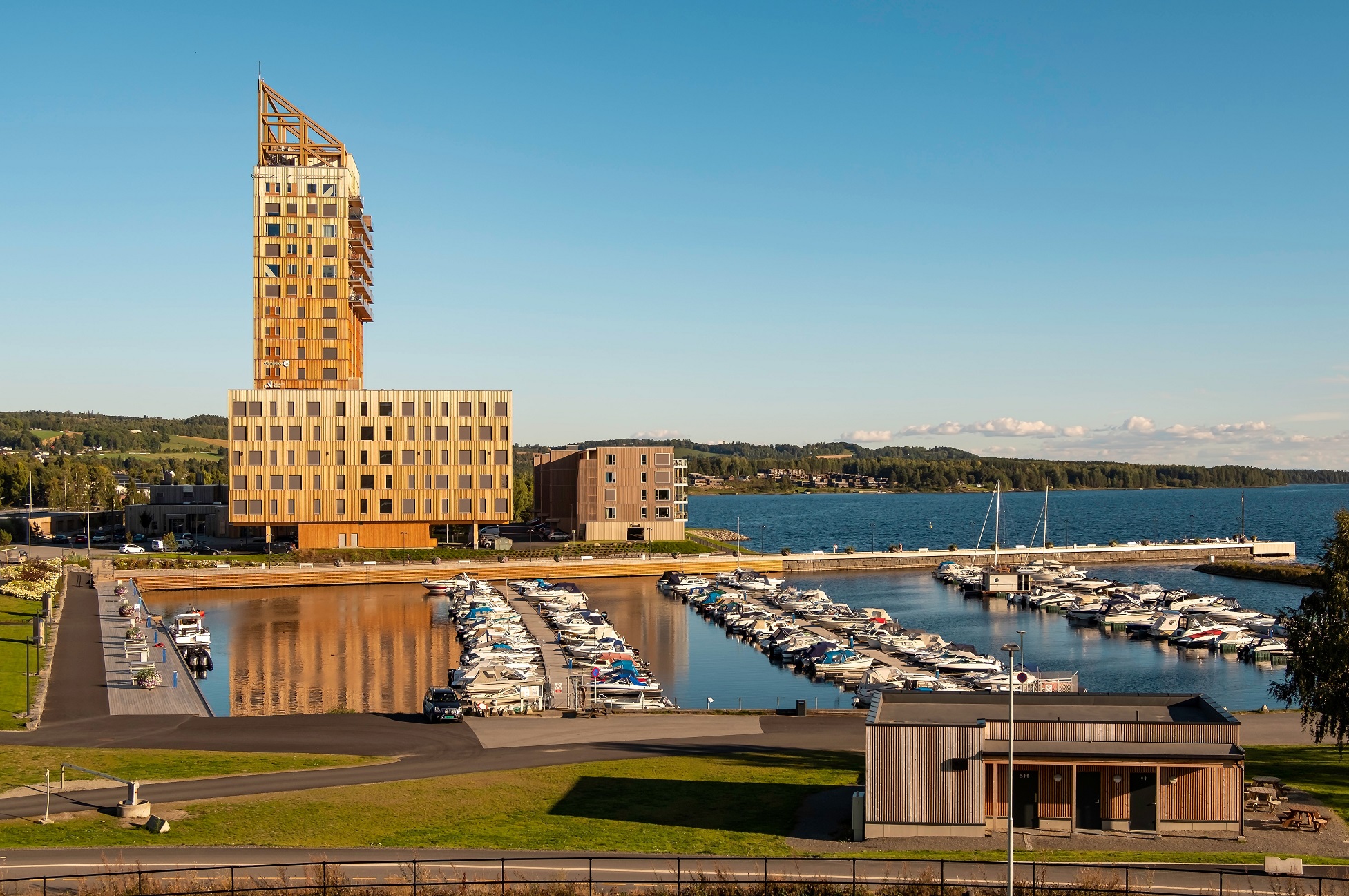A renaissance of wooden construction?

‘He found Poland wooden and left it made of brick’ is how the modernising successes of King Casimir the Great are summed up today. Wood symbolised backwardness, something to be replaced by another building material. So why does it now take the place of concrete, glass and steel?
The conditions were: they had to be built of perishable materials and completed within one year; they had to stand outside the city limits, but no further away than the distance of a cannon shot; and they could not have towers, bells or the traditional shape of a temple.
This was the challenge faced by Albrecht von Säbisch, a Prussian engineer and architect. And he managed it. He designed three churches with a timber-frame construction, i.e. made of wood, clay and straw. The Churches of Peace (created by the Peace of Westphalia, which ended the Thirty Years’ War) in Jawor, Świdnica and Głogów were built in the 1850s. The first two have survived to the present day (the Głogów one burnt down after a century) and are the largest Baroque religious buildings in Europe, built in a timber-frame construction. They have been inscribed on the UNESCO World Heritage List.
They are impressive, large (they can accommodate around 6,000-7,000 people) and, according to the website zabytek.pl, ‘are masterpieces of skilled craftsmanship. Because of their technological complexity and size, the Churches of Peace have never been replicated elsewhere and are one of a kind. […] The Churches of Peace required the builders to employ pioneering structural and architectural solutions on a scale and complexity never before seen in wooden architecture. Their success can be judged by their preservation to this day’.
Silesian temples – apart from the radio station tower in Gliwice, which is the tallest (111 m) all-wood structure in Europe – are actually the most significant instances of wood being used in construction in Poland. This once common building material has been displaced by other materials. For years, wooden construction in Poland was associated with poverty. The last buildings were still being constructed after the war, until the 1960s-70s. Then it was already brick. Made of wood – maybe a gazebo on a plot of land, a cottage in a holiday resort, a house in the mountains. And probably nothing else.
Hidden wood
However, this does not mean that the construction industry has forgotten about this raw material. It is used all the time, only that it is not visible. As Dr Andrzej Noskowiak of Łukasiewicz – PIT said in one of the episodes of the podcast ‘About Technology Out Loud’, ‘this is a feature of contemporary housing construction. We wouldn’t think it’s timber construction, because you can’t see the timber’. So where does it hide? Not only in the walls – often clad with other building materials. Roof trusses and ceilings are made of wood. It is also used to create beams, support elements and floor joists (on which boards are later laid) or – at the beginning of construction – formwork, into which foundations are poured.
Then there are the more visible elements, such as windows, doors, floors and the resurgent panelling. There may be no wood, but there is wood nonetheless. What if we went wild and used more of it?
Wood revealed
The world’s largest wood building complex is to be built on 25 hectares in Stockholm’s Sickla district. Construction is expected to begin in 2025 and be completed two years later. Stockholm Wood City will consist of 2,000 flats, 7,000 offices, as well as shops and restaurants. They are to be multi-storey buildings of minimalist form, heavily glazed, with distinctive razor blades at the windows and green roofs and facades.
Wood City is to be energy self-sufficient through the use of solar and thermal energy. It will usher in a new era of sustainable architecture and urban development, according to the developer, Atrium Ljungberg.
Swedish studio White Arkitekter, which designed the complex in Sickla together with Danish studio Henning Larsen, has another wooden development to its credit. This is the Sara cultural centre in the Swedish town of Skellefteå, nominated for the prestigious Mies van der Rohe Award 2024.
Sara consists of two parts. The first houses the cultural centre: a theatre, museum, art gallery and library. The second – a 75 m high tower – is the hotel. By building with wood, the designers paid homage to the local tradition of wooden construction. The investment was also part of the Skellefteå Municipality’s strategy to develop timber construction.
The tallest wooden building in Europe to date is the Mjøstårnet in the Norwegian town of Brumunddal (pictured). It is 85.4 metres high and has 18 floors. It houses a hotel, flats and offices. It was built from locally harvested timber. Just as Sarah’s structure was reinforced with concrete slabs, that of Mjøstårnet is wooden, and even the lift shafts were built from this material.
The Norwegian skyscraper will soon have some competitors. In 2027, the Rocket & Tigerli complex is due to be completed in the Swiss city of Winterthur. I Rocket will soar to 100 m and 32 floors (Tigerli will be its 23-metre base).
Prefabs
Modern timber buildings are, however, very different in technology from the cottages we remember from our holidays in the countryside. They are no longer log structures made from beams, but from prefabricated elements created in a factory. The most common technology is Mass Timber, and one of its types is Cross Laminated Timber (CLT). It consists of laying the boards in criss-cross (transversal) layers, usually an odd number of them. They are then glued together under pressure. The result is a wooden element that is highly resistant to loads, expansion and contraction.
Cross-glued timber is used to make panels – e.g. walls, ceilings or roofs. For the production of columns or floor beams, the so-called GLULAM, or Glued Laminated Timber, is more suitable. It is produced in a similar way to CLT, except that the boards are laid in layers with their grains lengthwise.
Constructing a house using Mass Timber technology is simple and fast, as the prefabricated construction elements already arrive on site. A single-family house is built in one or two days.
What are wooden buildings like?
- Fire resistant. The key here is the process of pyrolysis that occurs in wood exposed to high temperatures. A charred layer forms on its surface, which insulates the core of the wood. Of course, as the fire continues, this layer deepens, but the thicker the timber element, the longer it can withstand the pressure of the fire, giving time for emergency evacuation.
- Well insulated. This is because wood is a natural insulator and has a high heat capacity (as a reminder, this is the amount of heat required to change the temperature of a given body by a unit of temperature). As a result, for example, houses do not heat up quickly in hot weather.
- They maintain adequate humidity. This is another characteristic of wood. It releases excess moisture indoors and replenishes it when it becomes scarce indoors.
- More environmentally friendly. It is a fact that trees have to be cut down to make wood. But wood is a renewable material, because new trees are planted in the place of those cut down. Building sand, which is used to make concrete or glass, is not renewable. Its reserves are slowly running out and its extraction from riverbeds causes serious environmental problems.
The construction sector is responsible for 38-40 per cent of carbon dioxide emissions worldwide – we are talking about the construction and maintenance of buildings. Cement production alone accounts for 7-8 per cent of CO₂ emissions. The industry therefore has a lot of work to do to achieve the EU’s goal of zero greenhouse gas emissions in 2050. Hence, among other things, the bow to wood.
Not only does wood not emit CO₂, it actually consists largely of the carbon dioxide absorbed by the tree. The Andrewex company has estimated that around 100 m3 of wood is used to construct a 1500 m2 timber-framed building. This equates to approximately 67 tonnes of CO₂ stored in the building. Polish forests need… 4 minutes to compensate for the loss of wood used in the construction of such a building (after Energetyka24.pl).
More than 3,500 m³ of wood (from around 14,000 trees) was used to build the already mentioned Mjøstårnet skyscraper. The slightly lower HoHo Wien in the Austrian capital is made of 75 per cent wood. This saved around 2,800 tonnes of CO₂ during construction. The wood used in its construction was expected to regenerate in the forests in one hour and 17 minutes.
Will we live to see wooden skyscrapers in Poland?
According to the Statistics Poland (GUS), around 1 per cent of buildings in Poland are made of wood. Will there be more and will we live to see skyscrapers like Mjøstårnet or HoHo?
In May 2024, the French town of Pian Médoc inaugurated a demonstration building made as part of the BASAJAUN project, in which Lukasiewicz – PIT also participated. It has two storeys and was created using wood and other natural materials. The projecting roof protects the three flats inside from excessive sunlight. During the construction of the house, many innovative ecological solutions were used, which can be applied to other wooden buildings.




